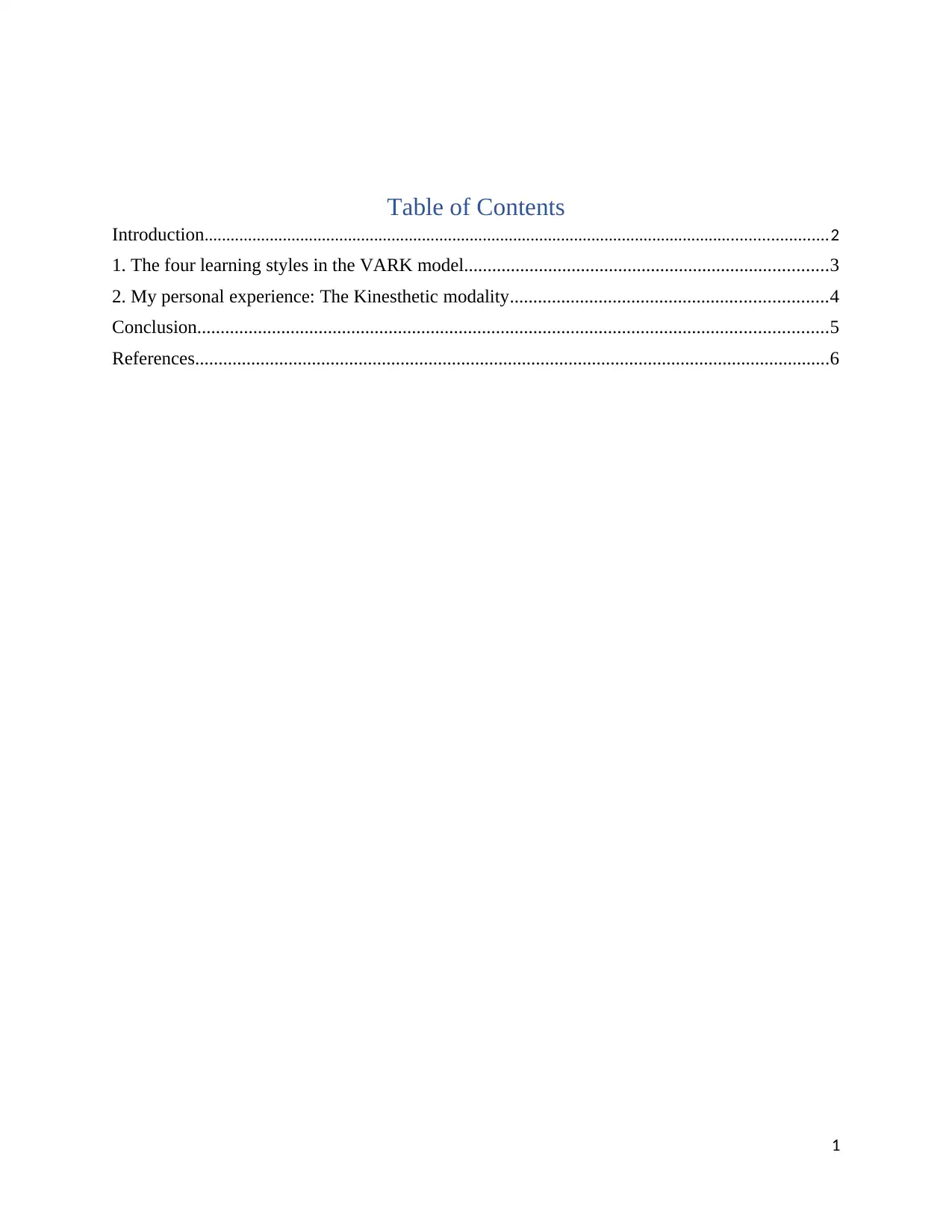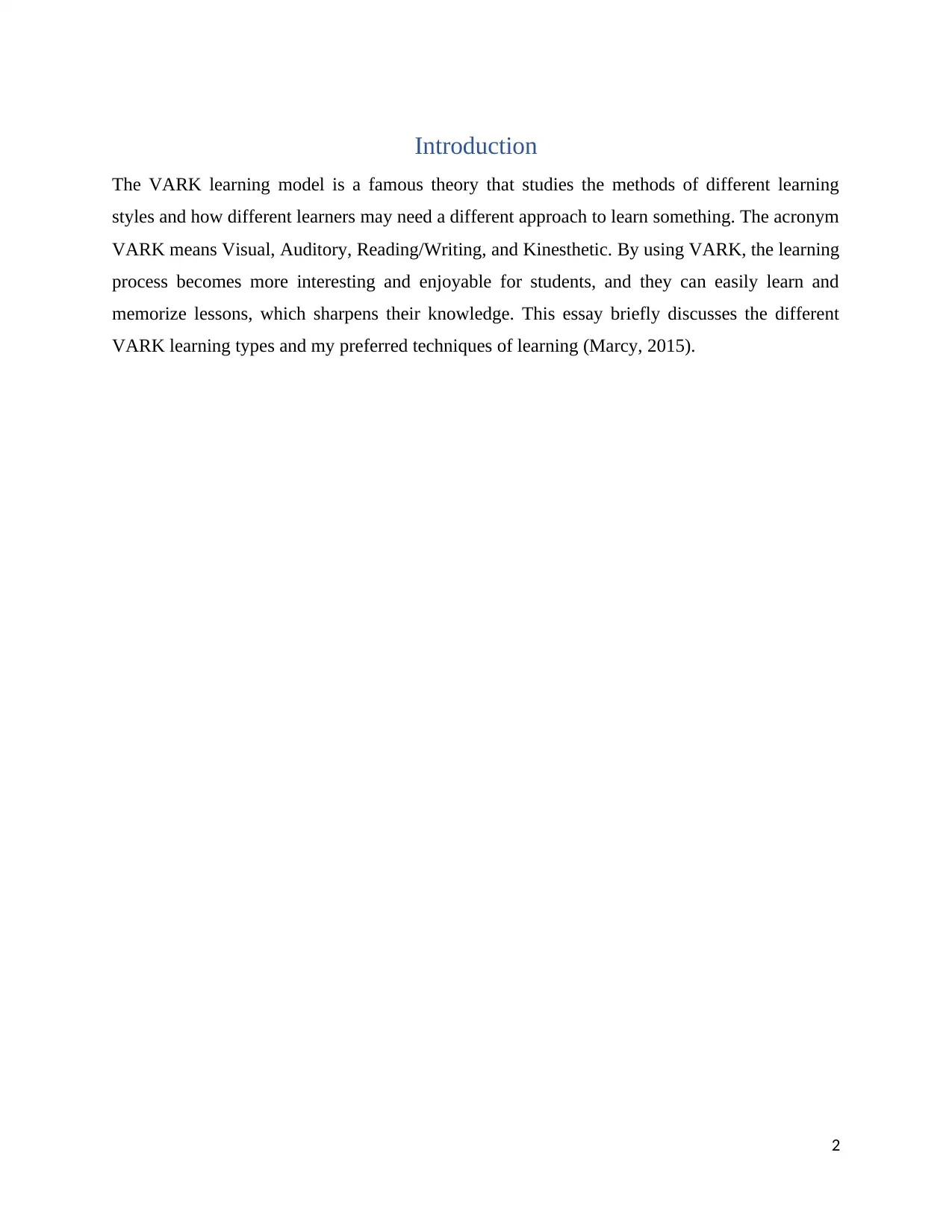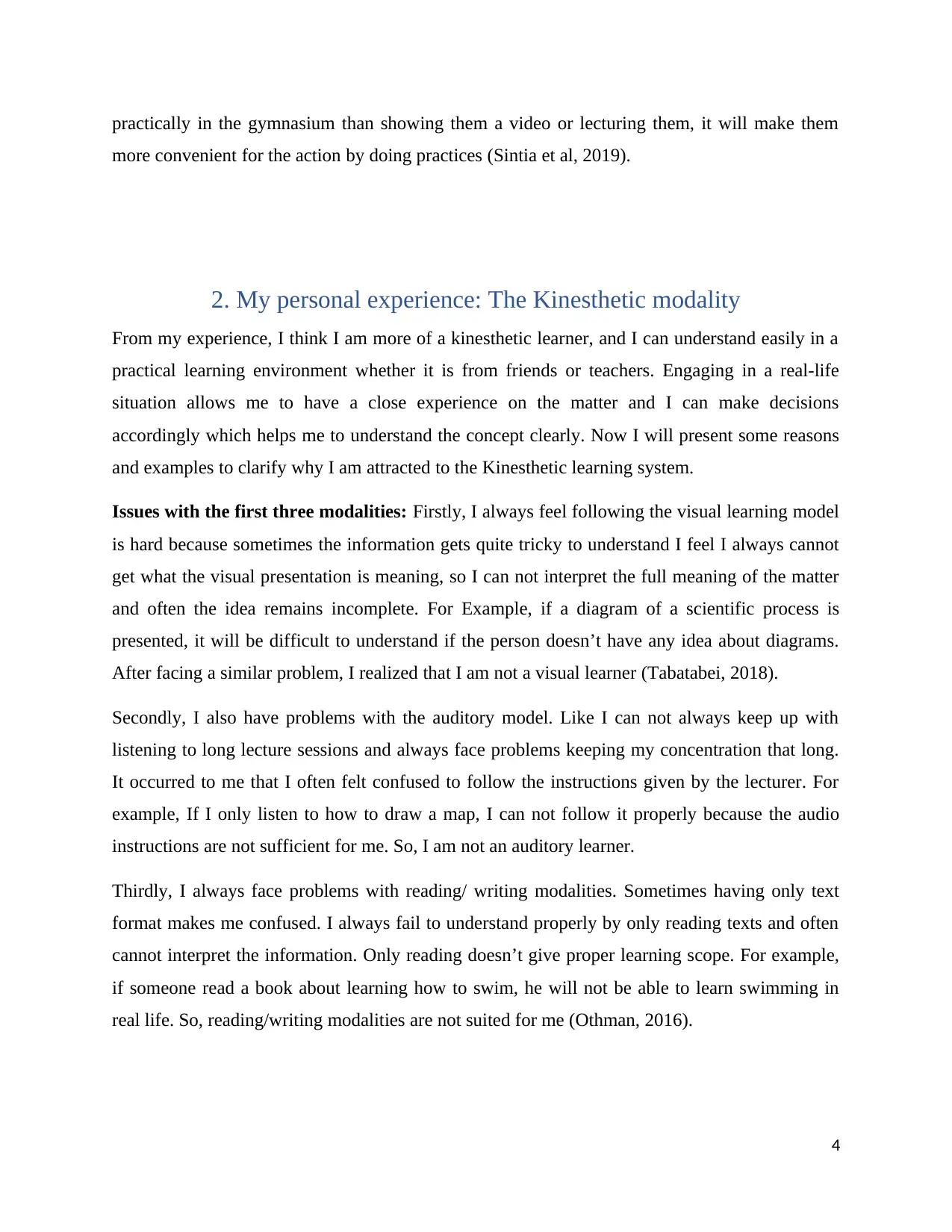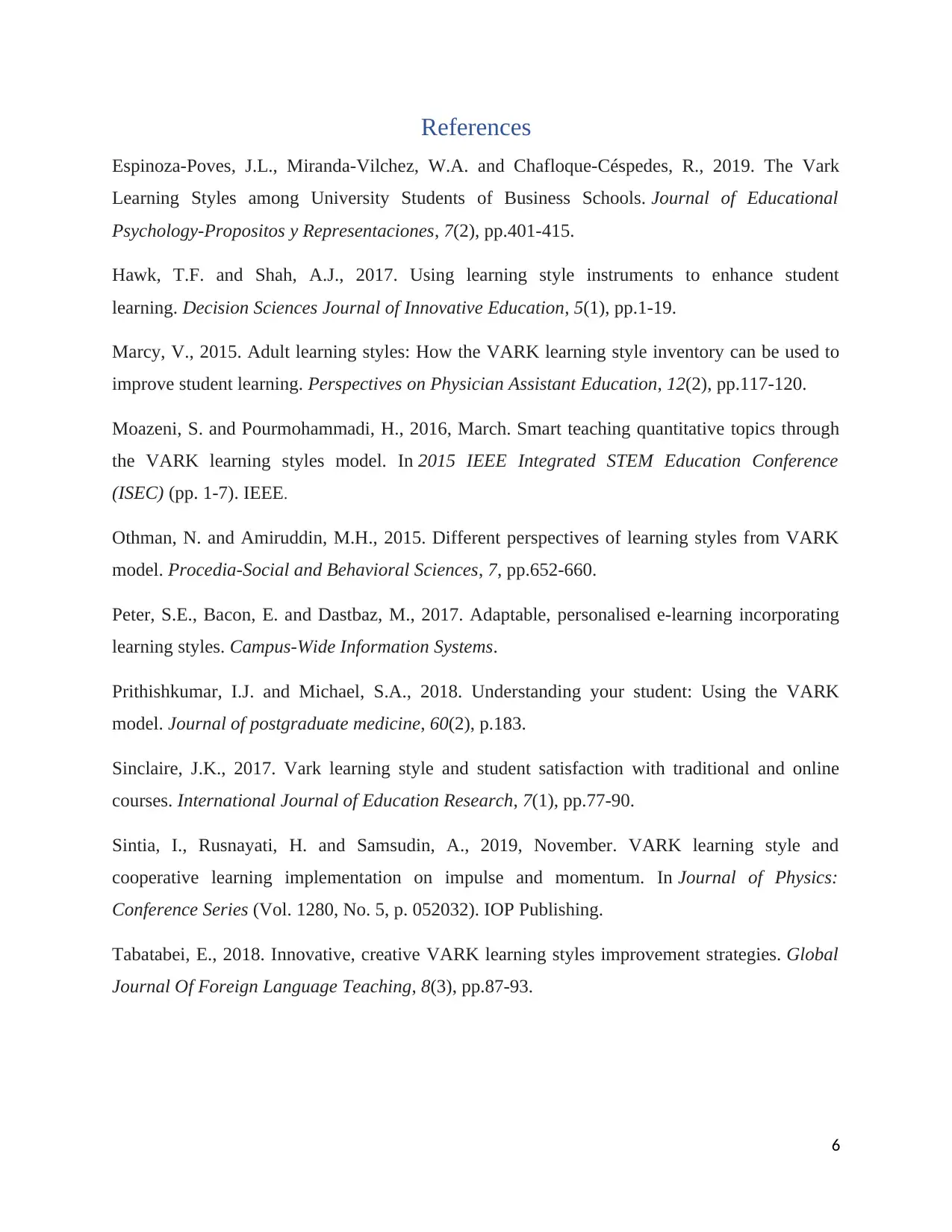Study Skills for Higher Education Assignment 2022
VerifiedAdded on 2022/10/12
|7
|1572
|23
Assignment
AI Summary
Contribute Materials
Your contribution can guide someone’s learning journey. Share your
documents today.

Study Skills for Higher Education
Secure Best Marks with AI Grader
Need help grading? Try our AI Grader for instant feedback on your assignments.

Table of Contents
Introduction...............................................................................................................................................2
1. The four learning styles in the VARK model..............................................................................3
2. My personal experience: The Kinesthetic modality....................................................................4
Conclusion.......................................................................................................................................5
References........................................................................................................................................6
1
Introduction...............................................................................................................................................2
1. The four learning styles in the VARK model..............................................................................3
2. My personal experience: The Kinesthetic modality....................................................................4
Conclusion.......................................................................................................................................5
References........................................................................................................................................6
1

Introduction
The VARK learning model is a famous theory that studies the methods of different learning
styles and how different learners may need a different approach to learn something. The acronym
VARK means Visual, Auditory, Reading/Writing, and Kinesthetic. By using VARK, the learning
process becomes more interesting and enjoyable for students, and they can easily learn and
memorize lessons, which sharpens their knowledge. This essay briefly discusses the different
VARK learning types and my preferred techniques of learning (Marcy, 2015).
2
The VARK learning model is a famous theory that studies the methods of different learning
styles and how different learners may need a different approach to learn something. The acronym
VARK means Visual, Auditory, Reading/Writing, and Kinesthetic. By using VARK, the learning
process becomes more interesting and enjoyable for students, and they can easily learn and
memorize lessons, which sharpens their knowledge. This essay briefly discusses the different
VARK learning types and my preferred techniques of learning (Marcy, 2015).
2

1. The four learning styles in the VARK model
The VARK learning model was developed to learn about the learning preferences of each
student. The VARK model includes four main learning modalities to make a structured and
interesting learning process for the students which will help each student to learn in a faster and
efficient way. Teachers can follow this model to evaluate the current teaching method and
processing and find out how the process can be improved further for the welfare of the students.
The VARK model discusses four types of learners, visual learner who learns by visual
information, auditory learners who learn by hearing or speaking, reading/writing learners who
learn well through any written text format, and kinesthetic learners who learn well by hands-on
and practical sessions (Sinclaire, 2017). These learning types are briefly discussed here:
Visual: This type of student prefers to learn by seeing things, like visual representation and
information. They can easily learn through maps, graphs, charts, diagrams, etc that are presented
visually. For example, a student can understand the scientific process easily when it is
represented by using flow charts. Students interpret and learn the message by highlighting
diagrams, patterns, and shapes of the given information (Peter et al, 2017).
Auditory: Auditory learners are the types of students who learn easily when they are given
information in audio form like lectures, presentations, audiobooks, etc. These students
understand better and interpret the concept clearly when they are involved in talking and hearing.
For example, a student can understand any complex lessons easily when he teams up with group
study and practices with them orally.
Reading/Writing: This type of student understands well using information given in any text
format like books, notes, lists, articles, etc. They prefer reading books to someone reading to
them and write notes when necessary. These types of students can easily interpret the problem by
reading. For example. If a student is given a written puzzle, he/ she will be able to solve that
easily if he/she is a reading/writing learner (Moazeni, 2016).
Kinesthetic: Kinesthetic learners are the students who learn well when they are faced in real life,
hands-on simulation, and practical setting. They prefer doing things in person than listening or
reading them. The kinesthetic learners are more connected to the real situation and require
practical experience to understand better. For example, if a teacher trains the gymnasts
3
The VARK learning model was developed to learn about the learning preferences of each
student. The VARK model includes four main learning modalities to make a structured and
interesting learning process for the students which will help each student to learn in a faster and
efficient way. Teachers can follow this model to evaluate the current teaching method and
processing and find out how the process can be improved further for the welfare of the students.
The VARK model discusses four types of learners, visual learner who learns by visual
information, auditory learners who learn by hearing or speaking, reading/writing learners who
learn well through any written text format, and kinesthetic learners who learn well by hands-on
and practical sessions (Sinclaire, 2017). These learning types are briefly discussed here:
Visual: This type of student prefers to learn by seeing things, like visual representation and
information. They can easily learn through maps, graphs, charts, diagrams, etc that are presented
visually. For example, a student can understand the scientific process easily when it is
represented by using flow charts. Students interpret and learn the message by highlighting
diagrams, patterns, and shapes of the given information (Peter et al, 2017).
Auditory: Auditory learners are the types of students who learn easily when they are given
information in audio form like lectures, presentations, audiobooks, etc. These students
understand better and interpret the concept clearly when they are involved in talking and hearing.
For example, a student can understand any complex lessons easily when he teams up with group
study and practices with them orally.
Reading/Writing: This type of student understands well using information given in any text
format like books, notes, lists, articles, etc. They prefer reading books to someone reading to
them and write notes when necessary. These types of students can easily interpret the problem by
reading. For example. If a student is given a written puzzle, he/ she will be able to solve that
easily if he/she is a reading/writing learner (Moazeni, 2016).
Kinesthetic: Kinesthetic learners are the students who learn well when they are faced in real life,
hands-on simulation, and practical setting. They prefer doing things in person than listening or
reading them. The kinesthetic learners are more connected to the real situation and require
practical experience to understand better. For example, if a teacher trains the gymnasts
3
Secure Best Marks with AI Grader
Need help grading? Try our AI Grader for instant feedback on your assignments.

practically in the gymnasium than showing them a video or lecturing them, it will make them
more convenient for the action by doing practices (Sintia et al, 2019).
2. My personal experience: The Kinesthetic modality
From my experience, I think I am more of a kinesthetic learner, and I can understand easily in a
practical learning environment whether it is from friends or teachers. Engaging in a real-life
situation allows me to have a close experience on the matter and I can make decisions
accordingly which helps me to understand the concept clearly. Now I will present some reasons
and examples to clarify why I am attracted to the Kinesthetic learning system.
Issues with the first three modalities: Firstly, I always feel following the visual learning model
is hard because sometimes the information gets quite tricky to understand I feel I always cannot
get what the visual presentation is meaning, so I can not interpret the full meaning of the matter
and often the idea remains incomplete. For Example, if a diagram of a scientific process is
presented, it will be difficult to understand if the person doesn’t have any idea about diagrams.
After facing a similar problem, I realized that I am not a visual learner (Tabatabei, 2018).
Secondly, I also have problems with the auditory model. Like I can not always keep up with
listening to long lecture sessions and always face problems keeping my concentration that long.
It occurred to me that I often felt confused to follow the instructions given by the lecturer. For
example, If I only listen to how to draw a map, I can not follow it properly because the audio
instructions are not sufficient for me. So, I am not an auditory learner.
Thirdly, I always face problems with reading/ writing modalities. Sometimes having only text
format makes me confused. I always fail to understand properly by only reading texts and often
cannot interpret the information. Only reading doesn’t give proper learning scope. For example,
if someone read a book about learning how to swim, he will not be able to learn swimming in
real life. So, reading/writing modalities are not suited for me (Othman, 2016).
4
more convenient for the action by doing practices (Sintia et al, 2019).
2. My personal experience: The Kinesthetic modality
From my experience, I think I am more of a kinesthetic learner, and I can understand easily in a
practical learning environment whether it is from friends or teachers. Engaging in a real-life
situation allows me to have a close experience on the matter and I can make decisions
accordingly which helps me to understand the concept clearly. Now I will present some reasons
and examples to clarify why I am attracted to the Kinesthetic learning system.
Issues with the first three modalities: Firstly, I always feel following the visual learning model
is hard because sometimes the information gets quite tricky to understand I feel I always cannot
get what the visual presentation is meaning, so I can not interpret the full meaning of the matter
and often the idea remains incomplete. For Example, if a diagram of a scientific process is
presented, it will be difficult to understand if the person doesn’t have any idea about diagrams.
After facing a similar problem, I realized that I am not a visual learner (Tabatabei, 2018).
Secondly, I also have problems with the auditory model. Like I can not always keep up with
listening to long lecture sessions and always face problems keeping my concentration that long.
It occurred to me that I often felt confused to follow the instructions given by the lecturer. For
example, If I only listen to how to draw a map, I can not follow it properly because the audio
instructions are not sufficient for me. So, I am not an auditory learner.
Thirdly, I always face problems with reading/ writing modalities. Sometimes having only text
format makes me confused. I always fail to understand properly by only reading texts and often
cannot interpret the information. Only reading doesn’t give proper learning scope. For example,
if someone read a book about learning how to swim, he will not be able to learn swimming in
real life. So, reading/writing modalities are not suited for me (Othman, 2016).
4

The effectiveness of Kinesthetic modalities: Finally, I think I am more comfortable with the
kinesthetic modality as it connects me to real-world scenarios where I can learn practically. This
modality allows me to experience the matter in person .and hands-on. I think I faced several
occasions where I had to make my decision personally. For example, preparing a presentation on
a given topic. I was able to make my plan, interpret it well and prepare to complete the task. In
completing this task, I faced some challenges, but I could overcome them as they were practical,
and I could solve them personally. So, from then, I started to think of myself as a kinesthetic
learner (Hawk, 2017)
Conclusion
So, this is how the four modalities of the VARK model are used in the learning process. Each
modality has different characteristics and is suitable for different learners. As for me, I feel more
comfortable with the kinesthetic modality as I can have real-life and practical experience which
is good for expressing personal learnings. So, this is all about the VARK learning model and my
personal experience with these learning modalities (Espinoza et al, 2019).
5
kinesthetic modality as it connects me to real-world scenarios where I can learn practically. This
modality allows me to experience the matter in person .and hands-on. I think I faced several
occasions where I had to make my decision personally. For example, preparing a presentation on
a given topic. I was able to make my plan, interpret it well and prepare to complete the task. In
completing this task, I faced some challenges, but I could overcome them as they were practical,
and I could solve them personally. So, from then, I started to think of myself as a kinesthetic
learner (Hawk, 2017)
Conclusion
So, this is how the four modalities of the VARK model are used in the learning process. Each
modality has different characteristics and is suitable for different learners. As for me, I feel more
comfortable with the kinesthetic modality as I can have real-life and practical experience which
is good for expressing personal learnings. So, this is all about the VARK learning model and my
personal experience with these learning modalities (Espinoza et al, 2019).
5

References
Espinoza-Poves, J.L., Miranda-Vilchez, W.A. and Chafloque-Céspedes, R., 2019. The Vark
Learning Styles among University Students of Business Schools. Journal of Educational
Psychology-Propositos y Representaciones, 7(2), pp.401-415.
Hawk, T.F. and Shah, A.J., 2017. Using learning style instruments to enhance student
learning. Decision Sciences Journal of Innovative Education, 5(1), pp.1-19.
Marcy, V., 2015. Adult learning styles: How the VARK learning style inventory can be used to
improve student learning. Perspectives on Physician Assistant Education, 12(2), pp.117-120.
Moazeni, S. and Pourmohammadi, H., 2016, March. Smart teaching quantitative topics through
the VARK learning styles model. In 2015 IEEE Integrated STEM Education Conference
(ISEC) (pp. 1-7). IEEE.
Othman, N. and Amiruddin, M.H., 2015. Different perspectives of learning styles from VARK
model. Procedia-Social and Behavioral Sciences, 7, pp.652-660.
Peter, S.E., Bacon, E. and Dastbaz, M., 2017. Adaptable, personalised e‐learning incorporating
learning styles. Campus-Wide Information Systems.
Prithishkumar, I.J. and Michael, S.A., 2018. Understanding your student: Using the VARK
model. Journal of postgraduate medicine, 60(2), p.183.
Sinclaire, J.K., 2017. Vark learning style and student satisfaction with traditional and online
courses. International Journal of Education Research, 7(1), pp.77-90.
Sintia, I., Rusnayati, H. and Samsudin, A., 2019, November. VARK learning style and
cooperative learning implementation on impulse and momentum. In Journal of Physics:
Conference Series (Vol. 1280, No. 5, p. 052032). IOP Publishing.
Tabatabei, E., 2018. Innovative, creative VARK learning styles improvement strategies. Global
Journal Of Foreign Language Teaching, 8(3), pp.87-93.
6
Espinoza-Poves, J.L., Miranda-Vilchez, W.A. and Chafloque-Céspedes, R., 2019. The Vark
Learning Styles among University Students of Business Schools. Journal of Educational
Psychology-Propositos y Representaciones, 7(2), pp.401-415.
Hawk, T.F. and Shah, A.J., 2017. Using learning style instruments to enhance student
learning. Decision Sciences Journal of Innovative Education, 5(1), pp.1-19.
Marcy, V., 2015. Adult learning styles: How the VARK learning style inventory can be used to
improve student learning. Perspectives on Physician Assistant Education, 12(2), pp.117-120.
Moazeni, S. and Pourmohammadi, H., 2016, March. Smart teaching quantitative topics through
the VARK learning styles model. In 2015 IEEE Integrated STEM Education Conference
(ISEC) (pp. 1-7). IEEE.
Othman, N. and Amiruddin, M.H., 2015. Different perspectives of learning styles from VARK
model. Procedia-Social and Behavioral Sciences, 7, pp.652-660.
Peter, S.E., Bacon, E. and Dastbaz, M., 2017. Adaptable, personalised e‐learning incorporating
learning styles. Campus-Wide Information Systems.
Prithishkumar, I.J. and Michael, S.A., 2018. Understanding your student: Using the VARK
model. Journal of postgraduate medicine, 60(2), p.183.
Sinclaire, J.K., 2017. Vark learning style and student satisfaction with traditional and online
courses. International Journal of Education Research, 7(1), pp.77-90.
Sintia, I., Rusnayati, H. and Samsudin, A., 2019, November. VARK learning style and
cooperative learning implementation on impulse and momentum. In Journal of Physics:
Conference Series (Vol. 1280, No. 5, p. 052032). IOP Publishing.
Tabatabei, E., 2018. Innovative, creative VARK learning styles improvement strategies. Global
Journal Of Foreign Language Teaching, 8(3), pp.87-93.
6
1 out of 7
Related Documents
Your All-in-One AI-Powered Toolkit for Academic Success.
+13062052269
info@desklib.com
Available 24*7 on WhatsApp / Email
![[object Object]](/_next/static/media/star-bottom.7253800d.svg)
Unlock your academic potential
© 2024 | Zucol Services PVT LTD | All rights reserved.





